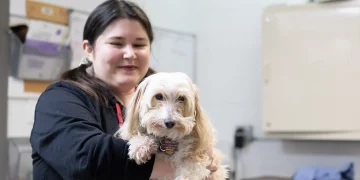Training your dog to follow basic commands such as “sit” and “come” is an essential part of establishing good behavior and communication between you and your pet. Not only do these commands help with day-to-day activities, but they also promote safety and foster a stronger bond between you and your dog. In this article, we’ll cover effective and easy methods for teaching your dog basic commands, starting with two of the most fundamental ones: “Sit” and “Come.”
Why Training Your Dog Is Important
Training your dog to follow basic commands isn’t just about teaching them tricks—it’s about creating a well-behaved and obedient pet. Here are some reasons why basic training is important:
- Safety: Commands like “come” can save your dog’s life in dangerous situations (e.g., when they’re about to run into traffic or get into something harmful).
- Socialization: Properly trained dogs tend to behave better around other people, dogs, and animals.
- Improved Communication: Training creates a language between you and your dog, allowing them to understand your expectations and cues.
- Bonding: The process of training fosters trust and strengthens the relationship between you and your dog.
Now let’s focus on two very important basic commands: “Sit” and “Come.”
Teaching Your Dog to Sit
The “sit” command is one of the easiest and first commands you can teach your dog. It’s often the foundation for other commands and helps with controlling your dog in various situations.
Step-by-Step Guide to Teaching “Sit”
1. Get Your Dog’s Attention
Start by making sure your dog is focused on you. You can use their name or a treat to get their attention. Hold a treat in your hand and let your dog see it.
2. Lure Your Dog into the Sitting Position
Hold the treat just above your dog’s nose, and slowly move your hand back towards their tail. As the treat moves, your dog’s head will follow, which naturally causes their rear end to lower. Most dogs will instinctively sit down to focus on the treat.
3. Give the Command
As soon as your dog’s rear hits the ground, say the word “Sit” clearly and firmly. Timing is key—ensure that you give the command at the exact moment they sit down.
4. Reward and Praise
As soon as your dog sits, give them the treat and offer verbal praise like “Good dog!” or “Yes!” Make sure to reward them immediately to create a positive association with the command.
5. Repeat and Practice
Repeat this process multiple times in short training sessions (about 5-10 minutes each). Keep sessions upbeat and fun, with plenty of praise and rewards. Gradually, your dog will begin to associate the word “sit” with the action of sitting down.
Tips for Success:
- Use Positive Reinforcement: Reward your dog every time they follow the command. Positive reinforcement is the best way to encourage behavior.
- Be Consistent: Always use the same word (“sit”) and hand gesture for the command. Consistency is key for your dog to learn.
- Short Training Sessions: Keep training sessions short and sweet. Dogs, especially puppies, have short attention spans.
- Gradual Fading of Lure: Once your dog starts sitting on command, you can begin fading the treat lure and using only the verbal command “Sit.”
Teaching Your Dog to Come
The “come” command is crucial for your dog’s safety. It’s especially helpful if your dog gets loose or is in an unsafe situation. Teaching “come” is a bit more challenging because it requires your dog to focus on you and move towards you.
Step-by-Step Guide to Teaching “Come”
1. Start Indoors or in a Controlled Environment
Begin training in a quiet environment with minimal distractions. A small, enclosed area like a room or backyard works best for this.
2. Use a Leash or Long Line (Optional)
If you’re worried about your dog running away, you can use a leash or long training line (15-20 feet) during the process. This helps you control their movements and ensures safety.
3. Get Your Dog’s Attention
Call your dog’s name and show them a treat. They need to focus on you, so get their attention before proceeding.
4. Give the “Come” Command
Hold the treat in your hand, crouch down to your dog’s level, and say “Come” in a friendly, enthusiastic tone. You can use an open-handed gesture, like patting your thighs or holding your arms out to encourage them to approach.
5. Reward as Soon as They Approach
As soon as your dog starts to come towards you, praise them and offer the treat. If you’re using a leash or long line, gently guide them towards you if needed. When they reach you, give them the treat and shower them with praise.
6. Gradual Distance Increase
Once your dog reliably comes when called from a short distance, gradually increase the distance between you and your dog. Start calling them from a few feet away, then increase the distance as they get better at the command.
Tips for Success:
- Make It Fun: Use an excited and happy tone when calling your dog. Dogs are more likely to respond to a high-energy, positive approach.
- Avoid Punishment: Never punish your dog if they don’t come when called. This will create negative associations with the “come” command and make them less likely to respond.
- Practice with a Long Line: If you’re outdoors, practicing with a long line can give your dog more freedom to explore while still being under control.
- Start in a Low-Distraction Area: Begin training in a quiet place and gradually introduce distractions as your dog becomes more consistent.

Additional Training Tips
1. Use Positive Reinforcement
Positive reinforcement—rewarding your dog with treats, praise, and affection—is the most effective way to train. This helps your dog understand that performing the desired behavior leads to something good. Avoid using punishment, as it can lead to fear, confusion, and stress.
2. Be Patient
Training takes time, and every dog learns at their own pace. If your dog doesn’t get it right away, don’t worry. Keep practicing in short, regular sessions, and remain patient. Dogs don’t learn commands in a single day, so persistence and consistency are key.
3. Keep Sessions Short and Fun
Dogs have short attention spans, especially puppies. Limit your training sessions to 5-10 minutes to avoid overwhelming them. Incorporate play and fun into the process so your dog enjoys the learning experience.
4. Consistency is Key
Consistency is vital to effective training. Always use the same word and hand gesture for each command, and make sure everyone in the household is on the same page with how to train your dog. This prevents confusion and reinforces the learning process.
5. Training Should Be a Positive Experience
Make sure training is a fun and rewarding experience for both you and your dog. If your dog is stressed or anxious during training, take a break and try again later. Over time, they will learn that training sessions are enjoyable and something to look forward to.
Common Mistakes to Avoid
- Overusing Treats: While treats are great for rewards, avoid over-relying on them. Gradually reduce the use of treats and replace them with verbal praise and affection to reinforce the behavior.
- Lack of Patience: Don’t expect instant results. Training takes time and consistency. Dogs learn best in small steps, so be patient and celebrate the progress they make.
- Punishing Incorrect Behavior: If your dog doesn’t get the command right, avoid punishment. Instead, redirect their behavior and try again. Negative reinforcement can harm your relationship with your dog.
Conclusion
Teaching your dog basic commands like “sit” and “come” is an essential part of responsible pet ownership. These commands not only help improve your dog’s behavior but also foster a deeper bond between you and your pet. By using positive reinforcement, consistency, and patience, you can effectively teach your dog these important commands. Remember to keep training sessions short, fun, and stress-free, and your dog will soon be sitting and coming on command with ease. Happy training!























































